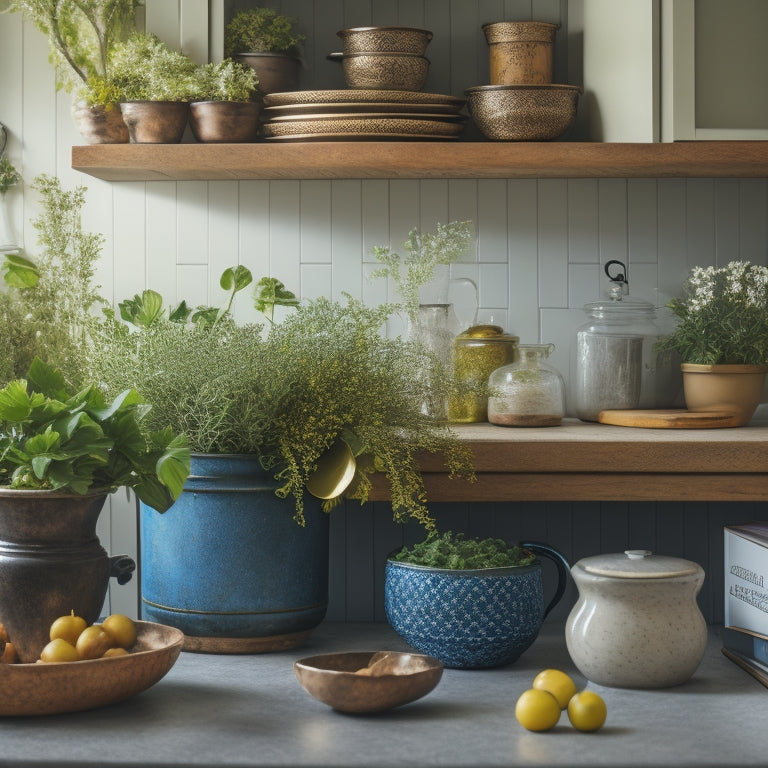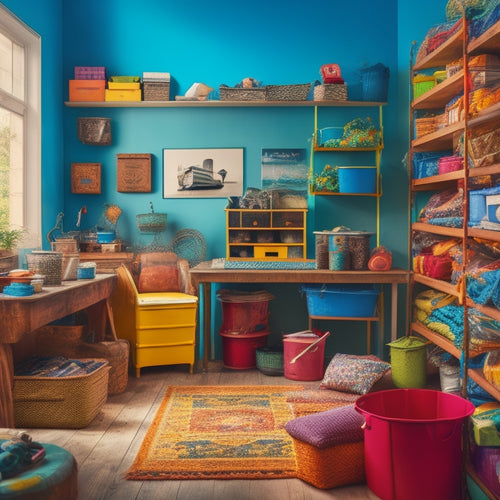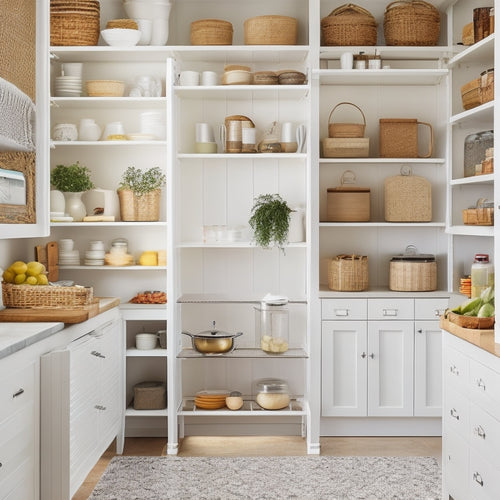
7 Tips for Organized Kitchen Counters With Drawers
Share
You're about to change your kitchen counters into a sleek, functional space where every item has its designated place, and clutter is a distant memory. Start by decluttering your countertops, assigning a home for each item, and choosing the right drawer size to maximize storage. Make use of vertical space efficiently, implement a "zone" organization system, and incorporate a junk drawer strategy to streamline your workflow. Finally, maintain your organized counters with daily, weekly, and monthly routines. As you commence on this expedition, you'll uncover even more creative ways to optimize your kitchen's potential, bringing you closer to a culinary haven that sparks joy and inspires creativity.
Key Takeaways
- Declutter your kitchen counters by adopting a minimalist approach, sorting items into keep, donate/sell, and discard piles, and creating a streamlined space for drawer installation.
- Assign a home for each item by categorizing kitchen items into groups and allocating designated storage spaces based on item size and frequency of use.
- Choose the right drawer size by considering ideal dimensions, reserving larger drawers for bulky items, and selecting durable materials that are easy to clean and visually appealing.
- Utilize vertical space efficiently by maximizing storage with tall cabinets and shelves, organizing shelves by grouping items, and installing vertical storage units to clear countertops.
- Implement a "zone" organization system by assigning specific countertop areas to distinct tasks, creating activity stations, and defining key zones for enhanced workflow.
Declutter Before Installing Drawers
How much stuff is currently cluttering your kitchen counters? Take a closer look – you'll likely find appliances, gadgets, and utensils vying for space.
To achieve organized kitchen counters with drawers, you need to start with a clean slate. Adopt a minimalist approach by clearing everything off your counters and sorting items into three piles: keep, donate/sell, and discard.
Recognize that emotional attachments to possessions can hold you back from letting go of items that no longer serve a purpose. Understand that clutter encompasses both physical and emotional aspects, and be honest with yourself about your motivations for holding onto certain items.
Use decluttering techniques like the "one-touch rule" to simplify the process. Be ruthless – if you haven't used it in the past year, it's probably safe to let it go.
Once you've purged your kitchen of unnecessary items, you'll be left with a more streamlined space, ready for the installation of drawers that will keep your essentials organized and within reach.
Assign a Home for Each Item
With your counters now cleared of clutter, you're ready to assign a home for each item, guaranteeing that everything has a designated place where it can be easily accessed and stored.
Start by categorizing your items into groups, such as baking supplies, cooking utensils, and breakfast essentials. Then, allocate designated spaces for each group, considering the frequency of use and the item's size.
For instance, store heavy items near the floor and frequently used items at eye level. This thoughtful planning will create a sense of order and make your kitchen feel more spacious.
Choose the Right Drawer Size
When selecting drawer sizes, you'll want to contemplate ideal dimensions that maximize storage while minimizing clutter.
Allocate space thoughtfully, reserving larger drawers for bulky items like pots and pans, and smaller ones for utensils and gadgets.
Optimal Drawer Dimensions
Your kitchen drawers are like a canvas, waiting for the perfect arrangement of utensils, gadgets, and cookware. To achieve ideal organization, consider the dimensions of your drawers. Typically, standard kitchen drawers range from 18 to 36 inches wide, 18 to 24 inches deep, and 3 to 6 inches high.
When selecting drawer materials, think about durability, ease of cleaning, and aesthetic appeal. For example, soft-close drawers with premium finishes can enhance your kitchen's style.
To maximize storage, choose drawer accessories like dividers, inserts, and trays that fit your specific needs. By selecting the right drawer size and accessories, you'll create a harmonious and functional kitchen space that reflects your personal style.
Drawer Space Allocation
By dividing your kitchen into zones, you can allocate drawer space efficiently, ensuring each zone has the right size and number of drawers to support its specific functions.
This thoughtful approach allows you to maximize storage and create a seamless workflow. For instance, a cooking zone might require a large drawer for pots and pans, while a prep zone benefits from smaller drawers for utensils and gadgets.
Consider the items you'll store in each drawer and choose the right size and accessories to support your workflow.
With drawer organization and accessories like dividers, inserts, and trays, you can customize your drawers to fit your unique needs, keeping your kitchen countertops clutter-free and organized.
Utilize Vertical Space Efficiently
Tall cabinets and shelves stretch towards the ceiling, providing ample opportunities to maximize your kitchen's vertical space.
You can optimize shelf organization by categorizing items into groups, storing frequently used items at eye level, and reserving higher shelves for infrequently used or bulk items.
Install vertical storage units, such as spice racks or utensil holders, to keep countertops clear.
Consider adding a pegboard or a pot rack to hang items like pots, pans, and utensils, freeing up cabinet space.
Implement a "Zone" Organization System
As you implement a "zone" organization system, you'll need to assign specific areas of your countertop to distinct tasks, like food prep, cooking, or baking.
By designating activity stations, you'll create a visually appealing and functional workflow that guides your movements through the kitchen.
Zone Assignment Strategy
Three key zones can convert your kitchen counters into a haven of efficiency: a cooking zone, a prep zone, and a landing zone. By assigning specific tasks to each zone, you'll enhance task efficiency and reduce clutter.
| Zone | Tasks | Drawer Contents |
|---|---|---|
| Cooking | Cooking, plating | Utensils, spices, oils |
| Prep | Chopping, dicing | Knives, cutting boards, bowls |
| Landing | Unloading groceries, sorting mail | Storage bins, trays, baskets |
Designate Activity Stations
Now that you've identified your kitchen's three key zones, it's time to get specific about what happens in each one. Within each zone, designate specific activity stations to maximize efficiency.
This activity grouping approach guarantees that everything you need for a particular task is within easy reach. Identify the station essentials required for each activity, such as utensils, appliances, and ingredients.
For example, your cooking zone might've a station dedicated to food prep, with a trash can, cutting board, and knife block nearby. Another station might be dedicated to cooking, with a stovetop, oven, and cookware storage.
Optimize Workflow Paths
Your kitchen's workflow is a choreographed dance of movement and activity, with each step and gesture precision-crafted to minimize clutter and maximize efficiency.
By implementing a "zone" organization system, you'll create distinct areas for prep, cooking, and cleaning, streamlining your workflow and reducing congestion. Assign specific tasks to each zone, ensuring frequently used items are within easy reach.
This thoughtful layout enhances counter accessibility, allowing you to glide effortlessly between tasks. As you optimize your workflow paths, you'll shave precious minutes off meal prep, freeing up time for more creative pursuits.
With a harmonious balance of form and function, your kitchen becomes a haven of workflow efficiency, where every move is deliberate and every moment is maximized.
Incorporate a Junk Drawer Strategy
Every kitchen has its Achilles' heel: a drawer that's a catch-all for miscellaneous items, from twist-tie collections to takeout menus.
To tame the chaos, designate a junk drawer and implement a strategy. Start by purging expired or useless items, then categorize the remaining essentials into groups like "batteries and cords," "manuals and warranties," or "office supplies."
Use dividers or small containers to create categorized storage within the drawer. This will help you maintain a sense of control and make it easier to find what you need when you need it.
Maintain Your Organized Counters
With your junk drawer strategy in place, turn your attention to the countertops, where clutter can quickly accumulate and overwhelm your newly organized space. To maintain your organized counters, establish a routine for daily kitchen maintenance. This includes wiping down surfaces, putting away utensils, and disposing of trash.
| Task | Frequency |
|---|---|
| Wipe down countertops | Daily |
| Clean up after meals | Immediately |
| Deep clean countertops | Weekly |
| Reorganize cluttered areas | Monthly |
Frequently Asked Questions
Can I Install Kitchen Counter Drawers Myself or Do I Need a Professional?
You can totally tackle DIY drawer installation, but be honest about your skills - if you're not comfy with measuring, cutting, and aligning, it's worth hiring a pro to guarantee a seamless kitchen renovation that's both functional and fabulous.
How Do I Decide Which Items to Store in Easy-To-Reach Drawers?
Imagine a skilled chef's kitchen, where every utensil has its perfect spot. You can create your own haven by considering accessibility factors: store frequently used drawer essentials, like sharp knives and spices, in easy-to-reach drawers, and reserve lower drawers for less-used items.
Are Soft-Close Drawers Worth the Extra Cost for Kitchen Counters?
When designing your dream kitchen, you're wondering if soft-close drawers are worth the extra cost. They offer a sleek, silent operation and increased durability compared to standard drawers, making the investment worthwhile for a stylish, high-performance kitchen that you can control with ease.
Can I Use Decorative Baskets to Store Items on Kitchen Counters?
You can enhance your counter organization by choosing decorative basket options that complement your kitchen style, and create a visually appealing space by grouping similar items together, like cookbooks or spices, for a cohesive look.
How Often Should I Clean and Reorganize My Kitchen Counter Drawers?
You'll want to clean and reorganize your kitchen counter drawers every 1-2 months to maintain a sense of calm and control, ensuring everything has its designated spot and cleaning frequency is customized to your personal drawer organization style.
Related Posts
-

What Are the Best DIY Storage Hacks Online?
You're looking for the best DIY storage hacks online! You've come to the right place. From repurposing old pallets an...
-

Why Cluttered Spaces Hold You Back From Productivity
You're struggling to get things done amidst the chaos of your cluttered space. It's not just a physical mess - it's m...
-

7 Smart Pantry Storage Hacks for Home Cooks
You can turn your pantry chaos into a culinary haven with these 7 smart storage hacks. Start by maximizing vertical s...


